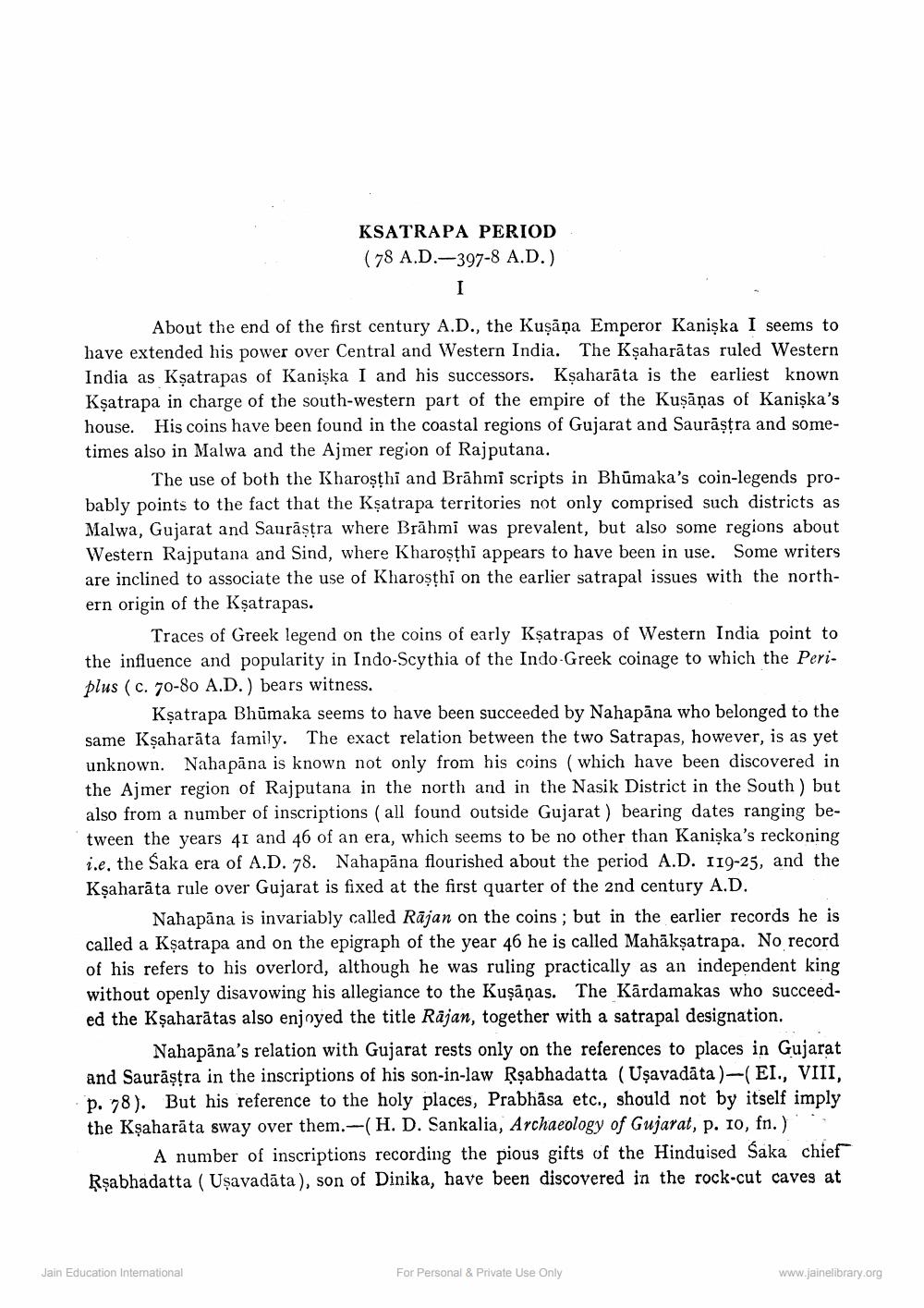________________
KSATRAPA PERIOD ( 78 A.D.-397-8 A.D.)
About the end of the first century A.D., the Kuşāņa Emperor Kaniska I seems to have extended his power over Central and Western India. The Kșaharātas ruled Western India as Kşatrapas of Kaniska I and his successors. Kşaharāta is the earliest known Kşatrapa in charge of the south-western part of the empire of the Kuşāņas of Kaniska's house. His coins have been found in the coastal regions of Gujarat and Saurāştra and sometimes also in Malwa and the Ajmer region of Rajputana.
The use of both the Kharoșthi and Brāhmi scripts in Bhūmaka's coin-legends probably points to the fact that the Ksatrapa territories not only comprised such districts as Malwa, Gujarat and Sausāstra where Brāhmi was prevalent, but also some regions about Western Rajputana and Sind, where Kharoșthi appears to have been in use. Some writers are inclined to associate the use of Kharoşthi on the earlier satrapal issues with the northern origin of the Kşatrapas.
Traces of Greek legend on the coins of early Kşatrapas of Western India point to the influence and popularity in Indo-Scythia of the Indo-Greek coinage to which the Periplus ( c. 70-80 A.D.) bears witness.
Kșatrapa Bhūmaka seems to have been succeeded by Nahapāna who belonged to the same Kşaharāta family. The exact relation between the two Satrapas, however, is as yet unknown. Nahapāna is known not only from his coins ( which have been discovered in the Ajmer region of Rajputana in the north and in the Nasik District in the South ) but also from a number of inscriptions ( all found outside Gujarat) bearing dates ranging between the years 41 and 46 of an era, which seems to be no other than Kaniska's reckoning i.e, the Saka era of A.D. 78. Nahapāna flourished about the period A.D. 119-25, and the Kșaharāta rule over Gujarat is fixed at the first quarter of the 2nd century A.D.
Nahapāna is invariably called Rājan on the coins; but in the earlier records he is called a Kşatrapa and on the epigraph of the year 46 he is called Mahākṣatrapa. No record of his refers to his overlord, although he was ruling practically as an independent king without openly disavowing his allegiance to the Kuşāņas. The Kardamakas who succeeded the Kşaharātas also enjoyed the title Rajan, together with a satrapal designation.
Nahapāna's relation with Gujarat rests only on the references to places in Gujarat and Saurāṣtra in the inscriptions of his son-in-law Rşabhadatta (Uşayadata )-(EI., VIII, p. 78). But his reference to the holy places, Prabhāsa etc., should not by itself imply the Kşaharāta sway over them.-(H. D. Sankalia, Archaeology of Gujarat, p. 1o, fn.)
A number of inscriptions recording the pious gifts of the Hinduised Saka chief Rşabhadatta (Uşavadāta), son of Dinika, have been discovered in the rock-cut caves at
Jain Education Intemational
For Personal & Private Use Only
www.jainelibrary.org




